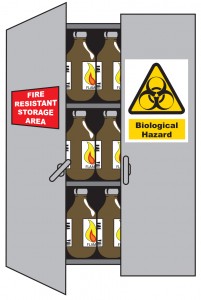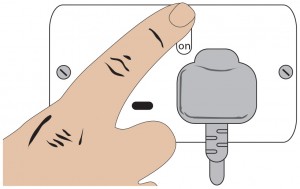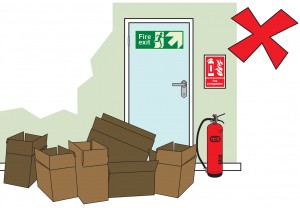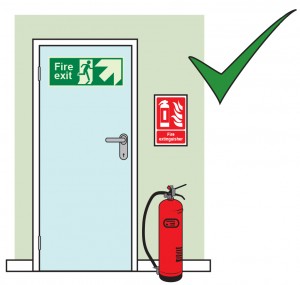In order to improve fire safety in the workplace, it is important to be aware of all existing fire hazards and the steps you can take to eliminate or minimise these hazards. You must also have an evacuation plan in place and ensure all employees are aware of the steps they must take in the event of fire.
For a fire to start three elements are required – a source of ignition, fuel and oxygen. Potential sources of ignition include naked flames, sparks and embers, reactive chemicals, electrical currents and high-temperature objects. Fuels can range from soft furnishings to common building materials to highly flammable substances like petroleum. Many everyday objects in the workplace could be considered as fuels.
A workplace fire safety risk assessment should be conducted to identify and assess potential fire hazards. Once completed, steps should be taken to either mitigate or minimise the risks identified in the assessment.
Flammable and combustible materials
Potential fire hazards in the workplace can include the use and storage of highly flammable materials or reactive chemicals. To reduce the chance of these becoming a potential fuel for a fire it is advisable to store these in a secure, fire resistant area, well away from all potential sources of ignition.
Extra care should be taken when moving and using highly flammable materials or reactive chemicals and these should be kept well away from sources of ignition at all times, except when necessary at the point of use. Any activity involving the deliberate ignition of highly flammable materials or exothermic chemical reactions should be undertaken under carefully controlled conditions according to established safety procedures.
Electrical devices
Electrical devices are a common source of fire in the workplace. Overloaded extension leads and damaged power cords are a particular danger. All electrical devices should be frequently monitored and tested to reduce this risk. Portable Appliance Testing (PAT) is a legal requirement under The Electricity at Work Regulations 1989. This aims to ensure that all electrical equipment which has the potential to cause injury or a fire is maintained to a safe
condition. A useful precaution to take in the workplace is to switch off and unplug all
electrical devices when they are not in use.
Reduce sources of ignition
All unnecessary heat sources and naked flames should be removed from the workplace in order to reduce potential sources of ignition for a fire. A no smoking policy should be enforced in all enclosed buildings, reducing the likelihood of an accidental fire.
Reduce hazards to staff
Blocked walkways and obstructed fire escapes are a potential hazard to staff in the event that a fire does occur. To facilitate a rapid evacuation, walkways and fire escape routes should be kept clear at all times. Fire exits should be clearly signed and doors should be free of any obstruction. However, any fire-resistant doors should be kept closed when not in use to stop fires spreading rapidly throughout the building. Fire action notices and equipment should be correctly located and available at all times to help in the event of a fire.
Fire risk assessments must be carried out regularly in every workplace to identify all existing fire hazards and put steps in place to mitigate the associated risks. A Fire Safety Log Book is available to record critical fire safety information including drills, staff training, emergency numbers and equipment.
In addition to regular risk assessments, all employees should be encouraged to immediately report any potential fire hazards.
Fire Safety Training
Fire Safety Training is available to help prepare employees for an outbreak of fire in the workplace and teach them the correct fire safety procedures to minimise the risk of casualties. The courses aim to improve employees’ confidence in dealing with these situations, and raise their awareness of potential fire hazards in the workplace.

